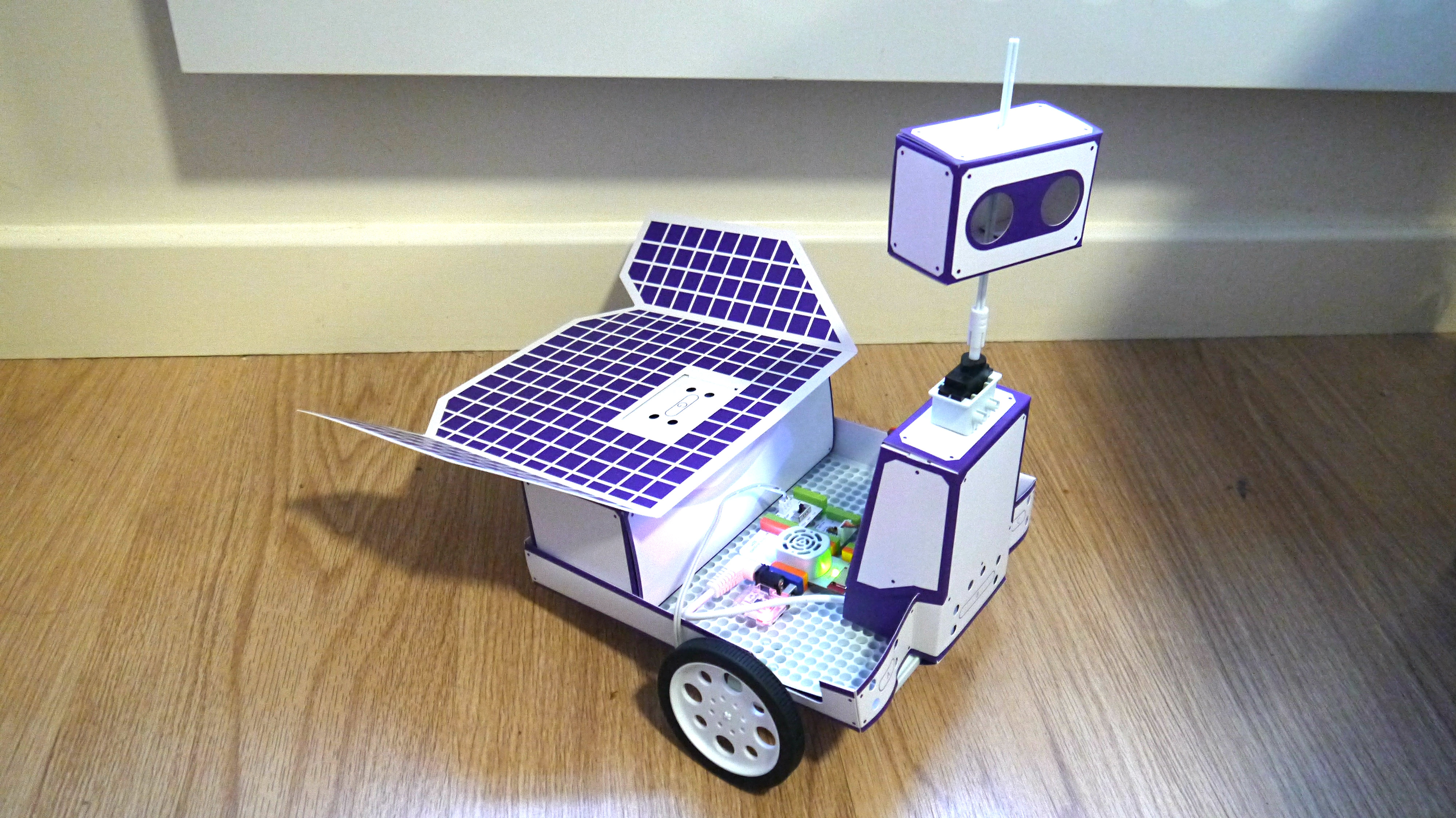TechRadar Verdict
The Space Rover Inventor Kit is fun, educational and versatile, but the high price means you should make sure your child has a genuine interest in STEM subjects before purchasing, otherwise you may find it doesn't engage them for long.
Pros
- +
Fun and challenging
- +
Educational
- +
Cute design
Cons
- -
Expensive
- -
Won’t suit very young children
- -
Some kids may find the instructions boring
Why you can trust TechRadar
STEM (science, technology, engineering and maths) toys are all the rage at the moment, and trailblazing educational toy company LittleBits knows this better than anyone. LittleBits believes Generation Z is “characterized by innovation and activism”, and has launched three new toys designed to empower kids.
We tried out one of these – the Space Rover Inventor Kit, which is inspired by the pioneering work of NASA (the other two are the Base Inventor Kit and Electronic Music Inventor Kit). Using the kit, kids can build their own working rover, using construction, circuitry and programming skills with guidance from the dedicated app.
Although we’re definitely towards the higher end of the 8+ age range LittleBits is aiming the Space Rover Inventor Kit at, we had a blast putting it together, and we think kids will love it too.

Price and availability
You can purchase the Space Rover Inventor Kit from the LittleBits website for $199.99 in the US – you can also get a further 10% off any purchases over $75 when you sign up to its mailing list.
UK buyers can get it from Amazon for £199.99, and if you’re in Australia, there’s a few online retailers you can buy it from, but we found it for AU$349 from JB Hi-Fi.
Of the three new inventor kits, the Space Rover is the most expensive, but it’s not the most expensive LittleBits toy you can buy – that's the Avengers Hero Inventor Kit retails at around $150 (£150 / AU$249) for example.
It’s difficult to compare the Space Rover to other STEM toys on the market as it’s such a broad category, but LittleBits toys generally sit at the higher end of the price scale.
Design and build
The idea of the Space Rover Inventor Kit is that kids can build and program their own working rover, which can be controlled via the LittleBits app (available for free on the App Store and Google Play). In the box you get cardboard templates, which you can fold and slot together to make the base, different circuit elements including LED lights, sensors, and a control hub, and stickers which you can use to decorate your rover.
The cardboard templates come in LittleBits’ characteristic purple and white color scheme, and each of the circuit components are brightly color-coded – blue for power, pink for input models (to interpret environmental data), green for output models (to make changes to the environment), and orange for components that alter the signal passing through the circuit, and allow you to branch your circuit in different directions.

Not only does the color coding make it easier to assemble the Space Rover, it also makes the end result look really attractive, and more appealing to kids who may find the idea of building circuits a little daunting.
Once you’ve assembled the Space Rover, you're left with a little robot that looks a little like Pixar’s Wall-E, with a rotating head, mechanical arm, and space hammer – it has heaps of personality, and we think kids will love the look of the final product.
The rover moves around using two large wheels, and can be controlled using the dedicated app, so you can make it move around your home and carry cargo, and pick up objects just like a real space rover.

What it’s like to use
Building the Space Rover is, in short, an absolute blast. With the app walking you through each step it’s easy to put everything together, although younger children may find following the instructions a little tedious, so it’s best to stick to the recommended age range of 8+ years.
We started out by making the rover base, by folding and connecting the cardboard cutouts. These are all numbered and color-coded for simplicity, and you don’t need to use scissors or adhesives, so the kit is safe for kids to use unattended (and they won’t make too much of a mess).
Every step of the construction is outlined by in-app videos, which can be paused and replayed as required, so kids can take their time and work at their own pace.
Once we'd finished the rover base, the app prompted us to start putting the circuitry together, which is again demonstrated in videos within the app, making it really easy to follow. When you’ve completed your basic circuit, the app shows you how to put the whole thing together using the included mounting board – the final result is the basic rover with wheels, which you can control using the in-app controls, although at this stage all you can do is make it move around.

The controls are very easy to use: simply connect your phone or tablet to the control hub part of the circuit (you’ll need Bluetooth switched on), and swipe the animated joystick to make the rover move.
This is the most basic version of the rover you can make, but as you work through the app you’re encouraged to add additional parts – you can add a rotating head, a mechanical arm to pick up objects, solar panels, and sensors, all of which require adding more circuit parts and cutouts.
There are also mini-games and challenges designed to test out your new creation, and how far you want to develop your rover is entirely up to you.
LittleBits says there are over 30 activities within the app that “guide kids through understanding the highly competitive space race and building and controlling space vehicle inventions, like a space rock collector or an alien life detector”.
Kids are also encouraged to be creative by decorating their invention with the stickers, and should be further inspired by the in-app articles about NASA pioneers like Mae Jemison, the first African-American woman to travel in space, and information on how NASA drives its rovers.

Final verdict
Overall the Space Rover Inventor Kit is great fun, and kids that are into programming, space, and DIY should have a great time putting it together and playing with it. However, if your child doesn’t already have an interest in these areas, the Space Rover could be a pretty pricey way of finding out that they actually don’t enjoy this kind of thing – it may be worth purchasing a cheaper STEM toy first to gauge their interest.
We found the instructions easy to follow, and loved the fact that demonstration videos were included for each step, making it really accessible to those who struggle with reading or following instructions – that said, it probably won’t be suitable for younger children, who may find it difficult to focus on one task for a long time.
We would have liked to see a little more information within the app on current NASA rover projects to add a little more context to what we were building, but we felt that overall, the ‘discovery’ parts of the app were informative and inclusive.
We think kids will get a nice feeling of accomplishment from building their own cute interactive robot, and they'll love controlling and customizing it; but ultimately how much your child gets out of the kit will be largely down to them, and how interesting they find space exploration and STEM subjects in general.
One issue with STEM toys is that they can often be a little one-dimensional (compared to, say, a doll or a playhouse, which can become anything with a child’s imagination); but with so many different ways to use the Space Rover Inventor Kit, we don’t think this will be a problem.
Olivia was previously TechRadar's Senior Editor - Home Entertainment, covering everything from headphones to TVs. Based in London, she's a popular music graduate who worked in the music industry before finding her calling in journalism. She's previously been interviewed on BBC Radio 5 Live on the subject of multi-room audio, chaired panel discussions on diversity in music festival lineups, and her bylines include T3, Stereoboard, What to Watch, Top Ten Reviews, Creative Bloq, and Croco Magazine. Olivia now has a career in PR.

